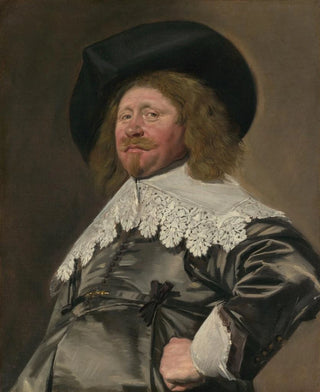Art print | Portrait of a man perhaps Nicolaes Pietersz Duyst van Voorhout born around 1600 died in 1650 - Frans Hals


View from behind

Frame (optional)
In the vast panorama of 17th-century Dutch painting, Frans Hals's work stands out for its liveliness and boldness. The "Art print Portrait of a man perhaps Nicolaes Pietersz Duyst van Voorhout" is a perfect example, where the artist manages to capture not only the physical appearance of his subject but also an almost palpable essence of his personality. This portrait, both intimate and powerful, invites us to contemplate the world of Dutch bourgeoisie while immersing us in Hals's technical mastery. Through this painting, the artist does not merely depict a man; he immortalizes an era, a culture, and an artistic sensibility that still resonate today.
Style and uniqueness of the work
Frans Hals's style is characterized by a dynamic and expressive approach, manifested in his bold brushstrokes and luminous palette. In this portrait, the artist uses rich colors to create striking contrasts, highlighting the features of his subject's face. Light plays a fundamental role, illuminating the face and hands, while the dark background emphasizes the presence of the man, placing him at the center of attention. Hals excels in capturing emotions, and here, the gaze of the character, both thoughtful and penetrating, engages us in a silent dialogue. This blend of realism and vitality gives the work an almost living dimension, as if the depicted man were about to come to life before our eyes.
The artist and his influence
Frans Hals, born in Antwerp in 1582 and active in Haarlem, is one of the most influential masters of Baroque painting. His work profoundly shaped the development of portraiture in the 17th century, standing out with a style that combines naturalism and expressiveness. Hals was able to breathe new life into portrait conventions by adopting a more personal and less formal approach than his contemporaries. His influence extends beyond his era, inspiring generations of artists, from Impressionists to modern painters, who admire his ability to capture light and movement.

Matte finish

View from behind

Frame (optional)
In the vast panorama of 17th-century Dutch painting, Frans Hals's work stands out for its liveliness and boldness. The "Art print Portrait of a man perhaps Nicolaes Pietersz Duyst van Voorhout" is a perfect example, where the artist manages to capture not only the physical appearance of his subject but also an almost palpable essence of his personality. This portrait, both intimate and powerful, invites us to contemplate the world of Dutch bourgeoisie while immersing us in Hals's technical mastery. Through this painting, the artist does not merely depict a man; he immortalizes an era, a culture, and an artistic sensibility that still resonate today.
Style and uniqueness of the work
Frans Hals's style is characterized by a dynamic and expressive approach, manifested in his bold brushstrokes and luminous palette. In this portrait, the artist uses rich colors to create striking contrasts, highlighting the features of his subject's face. Light plays a fundamental role, illuminating the face and hands, while the dark background emphasizes the presence of the man, placing him at the center of attention. Hals excels in capturing emotions, and here, the gaze of the character, both thoughtful and penetrating, engages us in a silent dialogue. This blend of realism and vitality gives the work an almost living dimension, as if the depicted man were about to come to life before our eyes.
The artist and his influence
Frans Hals, born in Antwerp in 1582 and active in Haarlem, is one of the most influential masters of Baroque painting. His work profoundly shaped the development of portraiture in the 17th century, standing out with a style that combines naturalism and expressiveness. Hals was able to breathe new life into portrait conventions by adopting a more personal and less formal approach than his contemporaries. His influence extends beyond his era, inspiring generations of artists, from Impressionists to modern painters, who admire his ability to capture light and movement.






